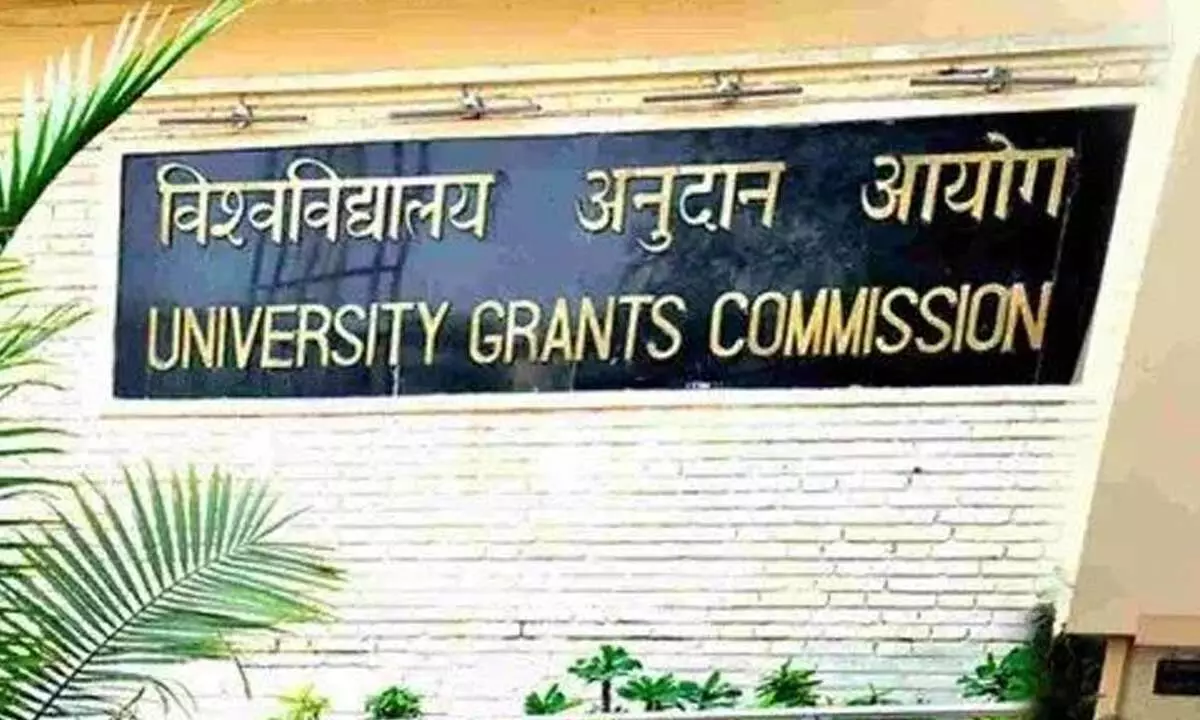Live
- Free Fire Max Redeem Codes for January 10: Get Exclusive Rewards
- Smell fresh with these top perfume picks for 2025!
- AP CM Chandrababu inaugurates NAREDCO property show
- Thoughtful and Unique Lohri Gifting Ideas to Spread Warmth and Cheer
- Asha Workers Stage Protest at Jadcherla MLA Camp Office, demanding hike in salary and other employee benefits
- Surprising Health Benefits of Eating Sprouts
- Purandareswari Emphasizes Cultural Education at YN College Diamond Jubilee Celebrations
- Andhra Pradesh Real Estate: Emerging Cities to Invest in 2025
- National Youth Day 2025: Celebrating Youth Empowerment and Swami Vivekananda’s Vision
- Today's Horoscope for January 10, 2025: Unlock the Powerful Daily Insights of Your Zodiac Sign
Just In
Draft UGC regulations: What students need to know


University Grants Commission
The University Grants Commission (UGC) has unveiled the Draft UGC (Minimum Standards of Instructions in the Award of Undergraduate and Postgraduate Degrees) Regulations, 2024 by M Jagadeesh Kumar, Chairman, UGC here on Thursday, marking a transformative step in reshaping India’s higher education landscape
The University Grants Commission (UGC) has unveiled the Draft UGC (Minimum Standards of Instructions in the Award of Undergraduate and Postgraduate Degrees) Regulations, 2024 by M Jagadeesh Kumar, Chairman, UGC here on Thursday, marking a transformative step in reshaping India’s higher education landscape. Aligned with the visionary National Education Policy (NEP) 2020, these regulations aim to create a flexible, inclusive, and multidisciplinary learning environment for students while bringing Indian education in line with global standards.
Flexibility and biannual admissions
One of the standout features of the draft regulations is the introduction of biannual admissions. Higher education institutions (HEIs) prepared to adopt this system can admit students twice a year, in July/August and January/February. This approach enhances accessibility and provides greater flexibility for learners, ensuring that no opportunity is lost due to rigid admission schedules.
Multiple entry and exit options
The draft regulations embrace the National Education Policy (NEP) 2020 by offering multiple entry and exit points in UG and PG programs. This ensures that students can take breaks and re-enter the academic system without losing their prior efforts. Provisions for Recognition of Prior Learning (RPL) further validate students’ previous academic or experiential learning, facilitating smoother transitions.
Flexibility in program choices
Under the new regulations, students can pursue two UG/PG programs simultaneously and are no longer restricted by their prior academic discipline. For instance, a science student can transition to a humanities course at the undergraduate or postgraduate level by qualifying in the relevant entrance examination, opening doors to interdisciplinary exploration.
Evolving attendance requirements
Acknowledging the rise of diverse learning modes, the draft regulations empower HEIs to determine student attendance requirements. This move ensures that attendance policies are aligned with the specific needs of different programs, fostering flexibility while maintaining academic rigor.
Reimagining credit distribution
To encourage holistic development, students are required to earn at least 50% of their credits in their major discipline. The remaining credits can be allocated to skill development, apprenticeships, or multidisciplinary subjects. This approach not only promotes employability but also nurtures a well-rounded academic profile.
Revised duration of degree programs
The regulations provide flexibility in the duration of UG and PG programs. For UG degrees, students can choose between a three-year or four-year program (with the option for honors or honors with research). Similarly, PG degrees can be pursued as a one-year or two-year program, depending on the student’s academic background and program structure.
Accelerated and extended degree programs (ADP/EDP)
The regulations also introduce provisions for Accelerated Degree Programs (ADP) and Extended Degree Programs (EDP). Key features include:
• Up to 10% of seats in HEIs can be reserved for ADP, with no limit for EDP.
• Students can opt for ADP or EDP by the end of their first or second semester.
• The curriculum and credit requirements remain unchanged; only the program duration varies.
• ADP allows students to complete their degree in a shorter time frame, while EDP provides additional time for those who need it.
Postgraduate eligibility
The regulations streamline eligibility for PG programs, ensuring clarity and inclusivity. Students completing a four-year UG degree with honors or research (e.g., B.Sc. Hons., B.Tech.) are eligible for a two-year PG program (e.g., M.Tech., M.Sc.), while other configurations are also accommodated to promote seamless academic progression.
Global standards with Indian roots
By embracing NEP 2020’s vision, the Draft UGC Regulations 2024 ensure that Indian higher education meets global benchmarks while catering to diverse learner needs. Provisions for flexibility, interdisciplinary learning, and skill development prepare students for the dynamic demands of the modern world.
The Draft UGC Regulations 2024 mark a paradigm shift in India’s higher education system, ensuring that it is adaptable, inclusive, and future-ready. With provisions like biannual admissions, multiple entry-exit points, flexible credit allocation, and innovative degree structures, these reforms promise to empower students and HEIs alike. As India advances toward becoming a global educational hub, these regulations will play a pivotal role in shaping the nation’s academic and professional landscape.

© 2025 Hyderabad Media House Limited/The Hans India. All rights reserved. Powered by hocalwire.com






